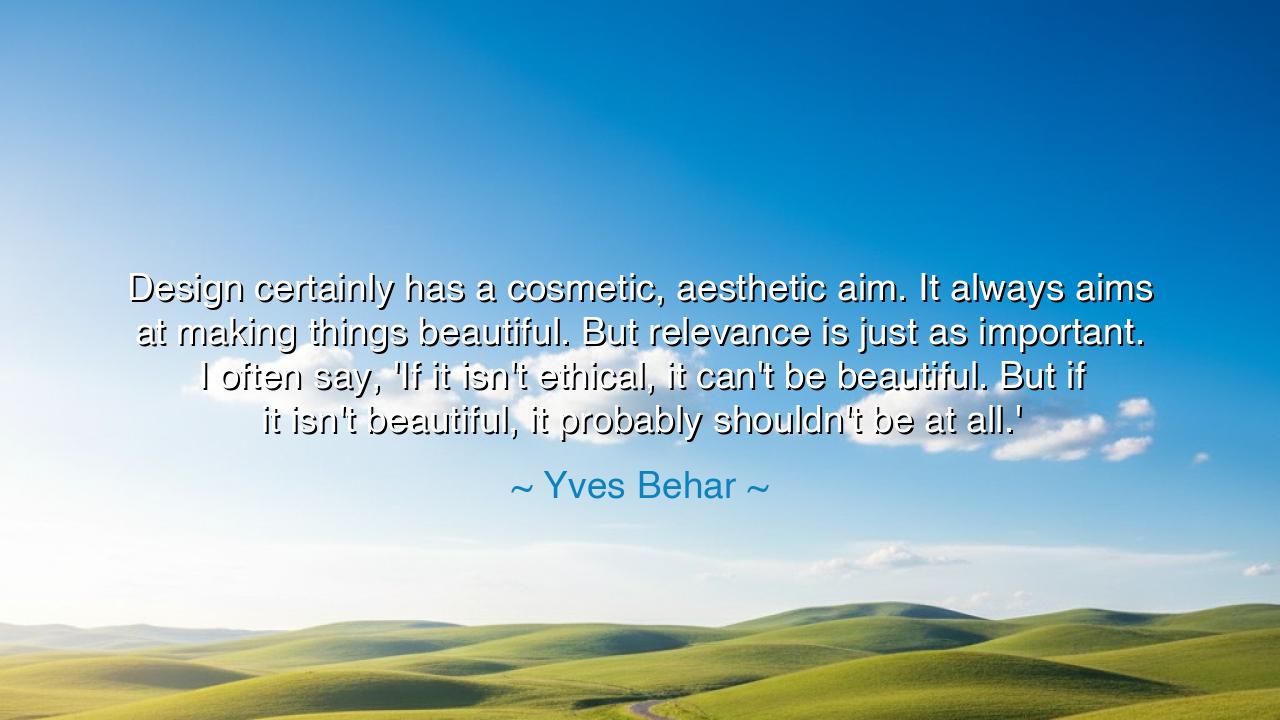
Design certainly has a cosmetic, aesthetic aim. It always aims at
Design certainly has a cosmetic, aesthetic aim. It always aims at making things beautiful. But relevance is just as important. I often say, 'If it isn't ethical, it can't be beautiful. But if it isn't beautiful, it probably shouldn't be at all.'






“Design certainly has a cosmetic, aesthetic aim. It always aims at making things beautiful. But relevance is just as important. I often say, ‘If it isn’t ethical, it can’t be beautiful. But if it isn’t beautiful, it probably shouldn’t be at all.’” Thus spoke Yves Béhar, a visionary of modern creation, a designer who sees beyond form and color into the moral heart of design itself. In this saying, he unites what the ancients once called the True, the Good, and the Beautiful—reminding us that no object, no work, no invention can truly be beautiful unless it is also ethical, and no design should exist if it fails to serve both the eye and the soul.
In Béhar’s words lies a revelation that reaches back to the foundations of civilization. For since the dawn of art and architecture, mankind has sought to bring beauty into the world—not as ornament alone, but as an expression of order, harmony, and virtue. The temples of Greece, the cathedrals of Europe, the gardens of the East—all were designed not only to please the senses, but to reflect something higher: the moral and spiritual ideals of their age. In this, Béhar stands among those ancient builders and philosophers, declaring once again that beauty without goodness is hollow, and ethics without beauty is lifeless.
When Béhar says, “If it isn’t ethical, it can’t be beautiful,” he strikes at the heart of modern creation. In an age where design too often serves consumption rather than compassion, his words rise as a warning. A chair that is elegant but made through exploitation, a building that dazzles but destroys the earth, a product that delights yet deceives—none of these can truly be called beautiful. For true beauty, like light, must reveal rather than conceal; it must elevate life, not diminish it. Ethics are the invisible architecture of beauty. Without them, even the most striking design becomes corruption wearing a mask.
Yet Béhar adds a second truth, equally profound: “If it isn’t beautiful, it probably shouldn’t be at all.” Here he does not speak of vanity, but of the responsibility of beauty. For beauty is not mere luxury—it is nourishment for the spirit. To make something ugly, something careless, something without thought or grace, is to add weight to the world’s weariness. A poorly designed object, a lifeless building, a joyless tool—these pollute the landscape of human experience just as surely as smoke pollutes the sky. Thus, Béhar reminds us that aesthetic excellence is not trivial—it is sacred. To design beautifully is to honor life itself.
Consider the ancient builders of the Parthenon, who shaped stone so perfectly that even the lines of imperfection were made to appear harmonious. They did not build merely to impress; they built to embody the divine. Their work was both ethical—serving a shared vision of civic and spiritual purpose—and beautiful, uplifting all who beheld it. The same spirit guided the craftsmen of the Japanese tea house, who created simplicity so profound it became poetry. In each case, the hand of the maker and the heart of the philosopher were one. This unity of purpose is what Béhar calls us back to—a design that serves, inspires, and endures.
But the designer’s challenge is not only for architects or artists—it is for all who shape the world in any form. Every human being is a designer of something: a life, a home, a relationship, a community. Béhar’s words therefore reach beyond the studio. They remind us that what we build—whether tangible or spiritual—must possess both integrity and grace. To live ethically without beauty is to deny joy; to live beautifully without ethics is to betray truth. Only when the two are woven together do we create something that lasts beyond us.
So, my listener, take this wisdom as a torch for your own path. When you create, ask yourself two questions: Is it good? and Is it beautiful? If it fails the first, it must not be born; if it fails the second, it must be born anew. Let beauty be not your vanity, but your act of reverence—for beauty reminds the world that life, even in its struggle, is worth celebrating. Let ethics be your foundation, for without it, your creation will crumble beneath the weight of its own falsehood.
Thus, remember the eternal law that Yves Béhar has restated for our age: that the good and the beautiful are inseparable, and that to design—whether in art or in life—is to weave them together. For in the harmony of ethics and beauty lies not only the perfection of an object, but the redemption of the human spirit. When your hands create with compassion and your mind shapes with love, your work—like all true design—will not merely exist. It will illuminate.






AAdministratorAdministrator
Welcome, honored guests. Please leave a comment, we will respond soon